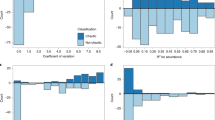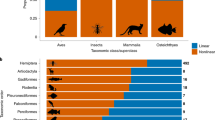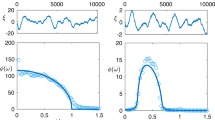Abstract
Chaotic ecological dynamic systems defy conventional statistical analysis. Systems with near-chaotic dynamics are little better. Such systems are almost invariably driven by endogenous dynamic processes plus demographic and environmental process noise, and are only observable with error. Their sensitivity to history means that minute changes in the driving noise realization, or the system parameters, will cause drastic changes in the system trajectory1. This sensitivity is inherited and amplified by the joint probability density of the observable data and the process noise, rendering it useless as the basis for obtaining measures of statistical fit. Because the joint density is the basis for the fit measures used by all conventional statistical methods2, this is a major theoretical shortcoming. The inability to make well-founded statistical inferences about biological dynamic models in the chaotic and near-chaotic regimes, other than on an ad hoc basis, leaves dynamic theory without the methods of quantitative validation that are essential tools in the rest of biological science. Here I show that this impasse can be resolved in a simple and general manner, using a method that requires only the ability to simulate the observed data on a system from the dynamic model about which inferences are required. The raw data series are reduced to phase-insensitive summary statistics, quantifying local dynamic structure and the distribution of observations. Simulation is used to obtain the mean and the covariance matrix of the statistics, given model parameters, allowing the construction of a ‘synthetic likelihood’ that assesses model fit. This likelihood can be explored using a straightforward Markov chain Monte Carlo sampler, but one further post-processing step returns pure likelihood-based inference. I apply the method to establish the dynamic nature of the fluctuations in Nicholson’s classic blowfly experiments3,4,5.
This is a preview of subscription content, access via your institution
Access options
Subscribe to this journal
Receive 51 print issues and online access
$199.00 per year
only $3.90 per issue
Buy this article
- Purchase on Springer Link
- Instant access to full article PDF
Prices may be subject to local taxes which are calculated during checkout



Similar content being viewed by others
References
May, R. M. Simple mathematical models with very complicated dynamics. Nature 261, 459–467 (1976)
Davison, A. C. Statistical Models 94–160, 456–458, 605–619 (Cambridge Univ. Press, 2003)
Gurney, W. S. C., Blythe, S. P. & Nisbet, R. M. Nicholson’s blowflies revisited. Nature 287, 17–21 (1980)
Nicholson, A. J. An outline of the dynamics of animal populations. Aust. J. Zool. 2, 9–65 (1954)
Nicholson, A. J. The self-adjustment of populations to change. Cold Spring Harb. Symp. Quant. Biol. 22, 153–173 (1957)
Turchin, P. Complex Population Dynamics 8–11, 47–77 (Princeton Univ. Press, 2003)
Kendall, B. E. et al. Why do populations cycle? A synthesis of statistical and mechanistic modeling approaches. Ecology 80, 1789–1805 (1999)
Cox, D. R. Principles of Statistical Inference 133–177 (Cambridge Univ. Press, 2006)
Beaumont, M. A., Zhang, W. & Balding, D. J. Approximate Bayesian computation in population genetics. Genetics 162, 2025–2035 (2002)
McFadden, D. A method of simulated moments for estimation of discrete response models without numerical integration. Econometrica 57, 995–1026 (1989)
Krzanowski, W. J. Principles of Multivariate Analysis: A User’s Perspective 60, 211–213, 231–235 (Oxford Univ. Press, 1988)
Campbell, N. A. Robust procedures in multivariate analysis. I: Robust covariance estimation. J. R. Stat. Soc. Ser. C 29, 231–237 (1980)
Gamerman, D. & Lopes, H. F. Markov Chain Monte Carlo: Stochastic Simulation for Bayesian Inference 2nd edn (CRC/Chapman & Hall, 2006)
Nisbet, R. M. & Gurney, W. S. C. Modelling Fluctuating Populations 285–308 (Wiley, 1982)
Silvey, S. D. Statistical Inference 68–86 (Chapman & Hall, 1975)
Takens, F. in Dynamical Systems and Turbulence (eds Rand, D. A. & Young, L.-S.) 366–381 (Lect. Notes Math. 898, Springer, 1981)
Cox, D. R. & Hinkley, D. V. Theoretical Statistics 11–58, 250–356 (Chapman & Hall, 1974)
Watkins, D. S. Fundamentals of Matrix Computation 128–132 (Wiley, 1991)
Acknowledgements
I am grateful to W. Gurney, R. Nisbet, S. Ellner, P. Turchin and B. Kendall for many discussions of the problem addressed here, and to the participants in the 2009 Statistical Methods for Dynamic Systems Models Workshop in Vancouver for discussion of this particular work. This work is part of the research programme of the EPSRC/NERC-funded UK National Centre for Statistical Ecology.
Author information
Authors and Affiliations
Corresponding author
Ethics declarations
Competing interests
The author declares no competing financial interests.
Supplementary information
Supplementary Information
This file contains Supplementary Information comprising: 1 Method Implementation and MCMC output; 2 Further examples; 3 Software: the sl package for R and References. (PDF 2805 kb)
Supplementary Data 1
This file is an R source package (suitable for use with R on unix like operating systems), implementing the examples in the paper and supplementary material, as well as the providing some routines for rapid computation of summary statistics, and robust evaluation. R is a free statistical language and environment available from cran.r-project.org. (ZIP 43 kb)
Supplementary Data 2
This file contains the same R package as in the Supplementary Data 1 file, but for the Windows version of R. (ZIP 105 kb)
Rights and permissions
About this article
Cite this article
Wood, S. Statistical inference for noisy nonlinear ecological dynamic systems. Nature 466, 1102–1104 (2010). https://doi.org/10.1038/nature09319
Received:
Accepted:
Published:
Issue Date:
DOI: https://doi.org/10.1038/nature09319
This article is cited by
-
Automatically discovering ordinary differential equations from data with sparse regression
Communications Physics (2024)
-
Estimated Covid-19 burden in Spain: ARCH underreported non-stationary time series
BMC Medical Research Methodology (2023)
-
Reconstructing computational system dynamics from neural data with recurrent neural networks
Nature Reviews Neuroscience (2023)
-
A synthetic likelihood approach for intractable markov random fields
Computational Statistics (2023)
-
Integrated Population Models: Achieving Their Potential
Journal of Statistical Theory and Practice (2023)
Comments
By submitting a comment you agree to abide by our Terms and Community Guidelines. If you find something abusive or that does not comply with our terms or guidelines please flag it as inappropriate.




